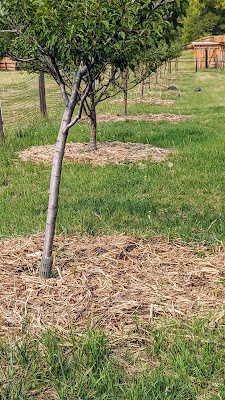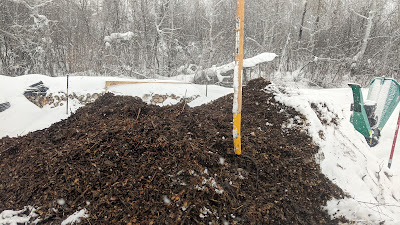Lesson 1: The Importance of Growing Healthy Trees
This is the first lesson of a 4 part fruit tree pest control course. If you would like to read the introductory outline for this course, please follow this link.
Fruit Tree Pest Control in 4 Simple Lessons
Introduction:
The world we live in has a real problem. We are all looking for a cure to some ailment, but rather than learning how to live a healthy lifestyle many of us compound the problem by turning to drugs, alcohol, and other addictive behaviors. Some people avoid such substances and behaviors on account of morals, so they go to a doctor, who is more than happy to write a prescription. After all, it's ok if, "the doctor said I had to".
Now, I understand that there are lots of ailments that are genetic and some people can't live without medications. You will see later in this course that there is a time and place for chemical pesticide use in fruit trees, but they are the exception, and should not be considered the standard.
In this lesson I will continue using this theme of human health and how it can be compared to fruit tree health. The reason for this analogy is that I believe fruit trees can help you have a healthier lifestyle. I will explain exactly how later.
Many modern diseases can be traced back to unhealthy living. Living a healthy lifestyle is not the easiest way to live, but it will make your life better. This is also true of growing healthy, organic fruit.
So, the first step to controlling pests and diseases is making sure that your fruit trees are as healthy as they can possibly be.
What is Good Health?
When you think of good health, what comes to mind? Diet and exercise? Well, that is one part of it. Physical health is important, and it can affect our mental health, and the health of our relationships. Without physical, mental, and social health, we cannot claim to be truly healthy. So let's compare these three categories to the health of your fruit trees.
Physical Health
Most people think of physical health as eating well, staying hydrated, and exercising often. When it comes to fruit trees, they too need plenty of food and water. They can't move so exercise is not an option, but pruning is.
Food
Fruit Trees don't have mouths and stomachs, so they don't eat, but they do metabolize sugars and starches. Where does this food come from? Photosynthesis. Trees make their own food using the light energy from the sun. By combining carbon dioxide from the air, and water from the soil, they create sugar and "exhale" oxygen. For more information follow this link:
 |
| Click Image to Zoom |
When gardeners say they are "feeding" their trees, what they really mean is that they are giving their trees, vitamins and minerals in the form of fertilizer - you can't really feed your tree. Vitamins and minerals are extremely important and a vital ingredient to a healthy tree.
Macro Nutrients
Chemical fertilizers are an inexpensive way of providing "macro nutrients" to your trees, but there is a better way. Macro nutrients are the chemicals that fruit trees, and other plants, need in the highest quantities. These nutrients have multiple functions in a plant, but we will briefly describe the primary purpose of each
Nitrogen
Nitrogen helps plants grow. It is used to create chlorophyll which is the part of the leaf that photosynthesizes. If a tree has plenty of nitrogen, it will grow fast and produce a lot of leaves and vegetative growth. Sound's good, but too much can make your tree soft and attractive to many pests and diseases.
Phosphorus
Phosphorus is important in the strengthening of roots and producing good blossoms in the spring. Phosphorus is also important in storing and transporting nutrients. Healthy roots will improve the overall health of your trees.
Potassium
Potassium is important in metabolizing the sugars that your trees creates and helps develop strong plant tissues which are more difficult for pests and diseases to penetrate.
Micro Nutrients
Micro nutrients are minerals that plants need in smaller quantities, but they are all necessary for healthy plants. Micro nutrients are needed in such small quantities, that plants can usually find them without supplemental fertilization. It's a good thing too, because most synthetic fertilizers don't include a very good balance or any micro nutrients at all.
Now that we understand plant food, let's talk about how plants can get it. We mentioned synthetic fertilizers, but fertilizer is like taking vitamins and dietary supplements instead of eating a well balanced diet. It is very possible to get all of your nutrients from your food, making vitamins and dietary supplements a waste of your money. Also, it's no secret that most vitamins that you buy in the store are not as easily absorbed in your body as the ones you get from your food.
The best way to make sure your fruit trees are getting all of the nutrients that they need is by regularly applying a thick cover of shredded tree mulch to the base of your trees that extends past the drip line. Many local tree service companies will drop off loads of mulch for free! To sign up for this service, you will need to make an account with an app called chip drop. Before you do, make sure you understand the good, the bad, and the ugly of free wood chip deliveries by following this link:
Chip drop: The good, the bad, and the ugly
When you mulch your trees with locally grown tree mulch, all of the macro and micro nutrients that the shredded tree collected is still in the mulch. All it takes is a healthy soil biology to make it accessible to your trees.
Local trees are growing in a similar soil type as your trees so you can bet that it was successful in acquiring the nutrients that your trees need. Shredded trees are free of weeds and salts that are found in high quantities in animal manures. Leaves can also be a good complete mulch free of weeds, and salts.
It is important to note that mulch is a top dressing and should not be incorporated into the soil. Mulch that is high in carbon and low in nitrogen will absorb nitrogen, making it inaccessible to fruit trees until it decomposes and is released back into the soil.
Topdressing will also allow the decomposition of the mulch to occur more slowly. The micro biology that lives in the soil will slowly pull the organic matter into the soil, but only when it has decomposed enough to make it useful to your trees. It works like a slow release fertilizer that keeps feeding your trees all year long, even in the middle of the winter when the ground is covered in snow.
The last benefit to topdressing is water absorption and retention. Because hydration is one of the main elements of healthy trees, lets go into a bit more detail.
Water
Fruit trees need plenty of water. As mentioned earlier, water is used to produce sugars in the leaves. Water is also used to transport those sugars from the canopy to the root system. In the other direction, water takes dissolved minerals from the soil to the canopy.
How much you water your trees is directly related to how much precipitation you receive. In addition to rain fall, temperature, solar energy, relative humidity, and soil type all affect how much water your fruit trees will need, but monitoring all of these elements and running them through a complex algorithm to determine the exact amount of water is not worth your time, and mental energy.
To simplify, most trees like moist soil. In other words, they like to have constant access to moisture, but roots metabolize sugars, which means they need to have oxygen. This means there needs to be air space in the soil. Sandy soils drain fast and always have plenty of oxygen, but dry out quickly. Loamy soils are ideal because they drain quickly leaving air pockets behind but hold water for longer. Clay soils on the other hand retain water and take a long time to dry. Clay particles are so small that they swell and have little to no air. Too much water in clay soils can suffocate tree roots and cause them to rot away.
If you have loam soils, then count yourself lucky! If not how do you keep the soil moist in sand and keep your trees from drowning in clay? Top dressing with shredded trees is your first remedy. Mulch over sand will shade, cool, and slow evaporation. Mulch over clay will improve soil biology. Worms, and insects live in the soil and feed on the mulch. As they move through the soil they are literally punching holes in you soil to allow for better drainage and more air pockets. Over time, adding more and more mulch will eventually change your soil from clay to organic. Organic soils act more like a nice loam with both benefits of water retention and drainage.
It's hard to over water trees planted in sandy or loamy soils, so erring on the wet side might be beneficial, but be responsible, clean water should not be wasted in the garden.
I know that soil biology is not simple, but mulching trees is. Mulching alone might be enough if you receive periodic rains. If you live in an arid climate, then you will need to supplement water to your trees. The simplest way to know when and how much water is needed is to scratch through the mulch and feel the soil underneath. if it feels moist, then wait to water. If it is starting to feel dry then water. I know that sounds over simplistic, but it is effective.
If you find that you are watering your trees consistently on a regular schedule, then you might want to set up an automated system. If you have the means, there are automatic watering systems that are tied to electronic soil moisture sensors. It is still important to make sure these are working, because electronics do fail.
Flood irrigation, drippers, and bubblers are all good way to supplement tree watering. Spraying trees with sprinklers can increase pests and diseases and should be avoided.
We covered food, we covered water, now lets get to exercise.
Pruning
Obviously, fruit trees can't exercise. They don't have any muscles. I like to compare pruning to exercise. Pruning is like cutting away the fat and building lean muscle. I won't go into much detail about pruning because I wrote a whole course about fruit tree pruning, and you can access that course here:
How to prune fruit trees in 9 simple lessons
Well, that pretty much covers the physical health of fruit trees. Fruit trees don't have brains, so how can you improve a tree's mental health?
Mental Health
We already discussed how fruit trees use light and carbon dioxide to make sugars. Sunlight and fresh air is crucial for fruit tree health. Without it, they will get sick and die. Some sun is better than no sun, but even then fruit trees planted in the shade will have a significant increase in pests and diseases. I know that fruit trees can't be mentally healthy without a brain, but they, like you and I, will be significantly better with plenty of sunshine and fresh air.
Social Health
Remember at the beginning of the lesson we talked about healthy relationships being key to your personal health? This also applies to fruit trees, but we will discuss this in detail in a future lesson.
Continue to the next lesson

.jpg)










Comments
Post a Comment